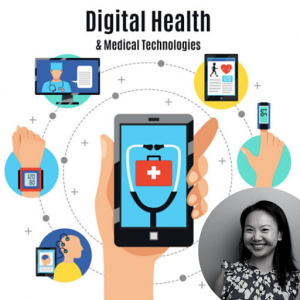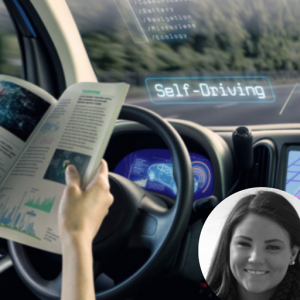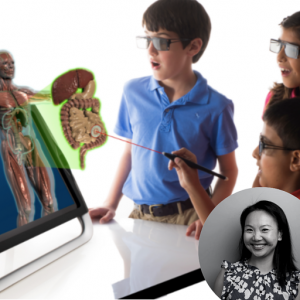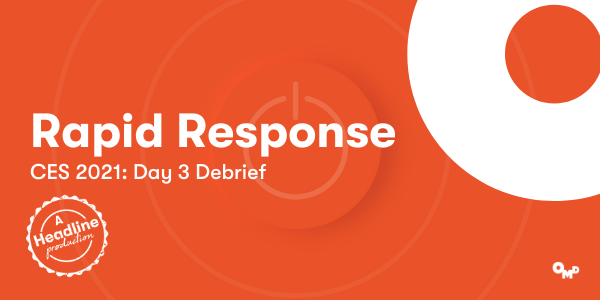It’s the final countdown. Yesterday, concluded CES’s virtual panel sessions. There were about 90 sessions along with three keynotes.
To round out the week topics ranging from digitized health, predictive AI, remote learning, cybersecurity, gaming, sustainability and autonomy led in conversation.
It’s been an exciting week! Today, concludes the 54th year of CES. Closing remarks and sign-up details for a full CES recap presentation will be emailed tomorrow. For now, please find highlights from yesterday’s events below.
Previous CES 2021 daily debriefs are available on Backstage here.


Microsoft Goes to the Cloud and Walmart Regenerates
Microsoft President Brad Smith’s keynote started the day. Illustrating technology as the fundamental tool powering communities and economies. Viewers were virtually transported to Microsoft’s cloud data center in Quincy, WA for a tour. Following, Smith emphasized humanity staying in control of technology; asking government to create diplomatic “rules of the road” for cybersecurity.
“We’ve long lived in a world where there were norms and rules that created expectations about what was appropriate and what was not. And, what happened with SolarWinds was not.” — Brad Smith, President, Microsoft.
Click here to learn more. Microsoft is the official technology partner of CES 2021.
Walmart’s President and CEO Doug McMillon spoke to AI’s ability to predict demand and personalization for Walmart+, having an omni-approach for Walmart Health, measuring the company’s diversity and inclusion progress, and becoming a regenerative company.
“This year we’ve set a big goal for Walmart to become a regenerative company. Meaning we don’t only offset some of the negatives that are in our supply chain, but we do other things to protect natural habitat… to reverse what is happening on our planet, and heal.” — Doug McMillon, President and CEO, Walmart
Client here to learn more.


Digital Health: Business Growth and Opportunities
Reporter: Shawna Huang, Director, Audio Investment
The pandemic unveiled the growing necessity for remote virtual care; specifically, around three key sectors: telehealth, mental/behavioral, and fitness/wellness. The consumer and physician adoption rate has enabled these digitized health services to become mainstream.
Beyond virtual at-home doctor appointments, telehealth also provides the opportunity for physicians to treat under-served populations in the current healthcare system.
Regulations and policies will need to be reviewed and recalibrated to adjust for the digital healthcare data pool. Thus, to ensure consumers protection and privacy.
Digital health investment soared this past year. In 2020 more than $14 billion was raised (+50% increase vs. 2019). Continued growth is anticipated. Garnering larger funds, healthcare investments will change our new “normal,”

2021 Gaming Trends and Tech
Reporter: Katherine Ahumada, Associate Director
In an ever evolving landscape, 2020 saw great momentum and adoption of gaming and E-sports due to COVID-19. As households looked to gaming consoles as a means for home entertainment and “virtual” socialization, dollar and unit sales were at an all-time record high for devices like Nintendo Switch and Switch like consoles.
The CTA projects “substantial growth in the digital gaming software and subscription categories of about $47 billion in revenue in the US (up 8% vs. 2020).”
Key players such as NVIDIA, LG, and Evil Geniuses will pioneer 2021 gaming innovation. Focused on spatial audio and enhanced HDR for higher performance levels in the competitive E-sports space. AI will aid content development and cognitive engagement for consumers.
As gamers needs and mechanical skills advance, technology in audio rate tracing, visual response rates and AI will continue to evolve in hardware development and content creation. The industry can expect to see desktop and monitor consoles adopt OLED, and leveraging AI to develop more mature in-game competitors.

The 3P’s of Demystifying AI for Marketers
Reporter: Abbey Sherrard, Director, Integrated Media Planning
AI may appear daunting, but with its implementation such as sentiment analysis, facial recognition, machine and deep learning, marketers can better understand their consumers.
By understanding and harnessing AI data streams, marketers can determine three key factors: patterns, preferences and predictions. In the world of COVID-19, AI demonstrates real-time consumer patterns so marketers can see what’s ahead. For example, the initial drop in car sales at the onset of the pandemic, which then quickly rebounded as a new consumer-base bought cars versus using public transit.
Utilizing AI against a data set allows marketers to unlock powerful insights to help meet business goals. Marketers need to invest in resources like data scientists and building an AI-powered data ecosystem. All data science starts with asking the right questions for your business.

Self-Driving Vehicles Moving Forward: Who Will Set the Rules?
Reporter: Jennifer Reese, Associate Director, Integrated Media Planning
While self-driving vehicles sound more like “Back to the Future,” these vehicles are already on our roads.
The US and UK governmental bodies in this panel session discussed the intrinsic categories pertinent for self-driving vehicles: collaborations, transparency, stakeholder engagement, research, safety, and data.
Regulations for self-driving vehicles will be the largest shake-up of transportation law in more than a generation. Creating and adjusting laws is only half the battle to integrating self-driving vehicles on the roadways.
The biggest hurdle is obtaining consumer trust. The best way the industry can combat this is through ongoing tests and transparent results.
In 10 years, self-driving vehicles will be a conversation of the past as we look towards advanced connected mobility at scale. The future of movement is freedom of movement for all, including those who are disabled or isolated.

Reimagining the Future of Education
Reporter: Shawna Huang, Director, Audio Investment
The past nine months were transformative as students worldwide moved to online learning.
Shifts in education have been a long time coming due to increased globalization and the digital revolution.
EdTech advancements have democratized access to online courses, used AI and robotics for personalized learning, and has created immersive educational experiences via gaming and AR/XR.
This past year has seen a record number of online learners (e.g. Coursera reported 250% YoY increase in registration). Investments for online learning are anticipated to grow from $160 billion in 2020 to $1 trillion by 2027.
To quote Jamie Dimon, “The future of work is skills, so stop worrying about degrees.” Technology has enabled learners of all ages to maintain skills and relevancy in today’s world.

Starting with Sports: The Health & Wellness Future
Reporter: Francesca Rizzuto, Supervisor, Published Media
Home fitness is in demand with AI-powered technology at its core. Fitness tech has become hyper-focused on the user experience to drive better performance outcomes. Real-time data from wearables and connected equipment allow users to personalize their fitness plans.
Popular athleisure brands like Lululemon are partnering with new tech (i.e. The Mirror acquisition in 2020) to expand market opportunities and have a presence in consumers’ homes – the new gym.
A new, first-of-its-kind connected fitness platform for the home, Liteboxer, was developed. This engaging full-body boxing workout combines advanced technology, music and expert training in one platform.
The transformation of at-home fitness has synced mind, body and tech. By using AI and gamification, the wellness industry is going to continue to create endless opportunities for brands to integrate every step of the consumer’s journey towards a holistically healthy lifestyle.

AI and Education: Moxie
Meet Moxie –– the educational robot for kids. The California based and Sony backed startup called Embodied created Moxie to promote cognitive, emotional, and social learning in children. Acting as an empathetic buddy and teacher, Moxie is designed to share new lesson plans that are available for download weekly via a cloud based subscription model. Moxie’s data will be encrypted, with parents or guardians being the only ones able to access the data for their particular unit.
For more information click here.




